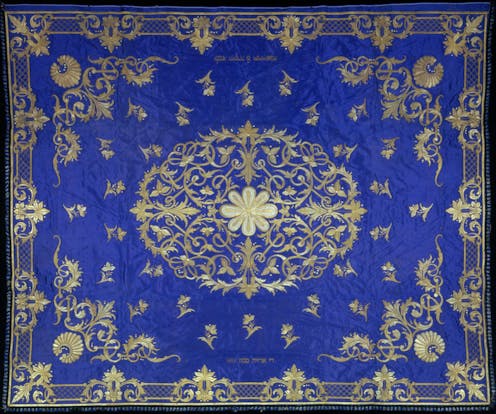
A Jewish wedding canopy, or ‘chuppah,’ made in the 1860s, from the Jewish Museum’s collection. Fine Art Images/Heritage Images/Getty Images
Anita Diamant, the prolific writer and Jewish feminist activist, begins her book “The Jewish Wedding Now” with a simple statement: “According to Jewish law, the requirements for a kosher wedding can be summed up in a few words: a bride accepts an object worth more than a dime from a groom; the groom recites a ritual formula to consecrate the transaction; the actions are witnessed by two people who are not related to either bride or groom. That’s it.”
But actual Jewish weddings are much more than that: They have before, during and after phases, and they vary widely throughout the world.
To explore Jewish women’s experiences of their weddings, my new book, “100 Jewish Brides,” co-edited with fellow sociologist Barbara Vinick, offers accounts written by Jewish brides – or their relatives, friends or clergy – from 100 different countries. The writers typically begin with experiences that occurred long before the wedding, especially how, when and where they met the person whom they would marry. Many Jews believe that one person exists on Earth who is destined to be their partner, their “beshert.” Brides also have heard wedding narratives from an early age, which they are eager to fulfill.
An especially prominent theme in the brides’ stories is pre-wedding practices, both religious and secular.
Cantor Rachelle Nelson officiates during a Jewish wedding ceremony in 2021 for Gene Yaffee and Faye Albert at The Palace Coral Gables, a senior living residence in Florida.
AP Photo/Lynne Sladky
The mikvah party
Religious Jews prepare their weddings around halachic regulations – that is, Jewish law. These may include practicing “shomer negiyah” – not touching each other at all, from the moment the couple meet until they stand under the chuppah, or wedding canopy. The couple may also fast on the day of the wedding. Sir Jonathan Sacks, the late chief rabbi of the United Kingdom, encouraged couples to use part of the pre-wedding period to draft a prenuptial agreement to prevent future problems around divorce.
The pre-wedding obligation of mikvah, or mikveh – when the naked bride fully immerses in a pool of flowing water – is essential for observant Jews and is becoming attractive to non-Orthodox Jews, as the mikvah pool has modernized. In Jewish history, immersing is so important that a Jewish community must create a mikvah before building any other structure.
The bride’s immersion before marriage has several meanings. The meticulous cleaning of her body symbolizes purifying herself for marriage and sexual intimacy and coming closer to God. For some Jewish women, the premarital immersion may also mark the start of her monthly immersion in coordination with her menstrual cycle.
Inside a mikvah in Crown Heights, Brooklyn, N.Y.
Mk17b via Wikimedia Commons, CC BY-SA
In our book, women from Greece, Israel, Mexico, Morocco, Pakistan, Uzbekistan and Yemen described their mikvah ceremony as both a solemn spiritual experience and a group celebration. “Leona,” a charming Mexican film, opens with a long segment in which the soon-to-be-married bride swims underwater while her female friends and relatives sit around the pool laughing and singing. The mikvah party binds the entire group and passes the tradition on to the future brides.
Zanet Battinou, from Greece, wrote about having her mikvah in the sea as her mother, mother-in-law, grandmother and friends sat on the beach. “My friends brought sweets to nibble on, and my mom-in-law prepared the traditional basket of luxurious towels, perfume, and bathroom goodies that every bride receives,” she recalled. “I have kept the lovely towels for my daughter to use someday, please God. My mikveh was full of love, meaning and reverence. I will never forget it.”
The henna party
A woman prepares to apply henna to women’s hands at a celebration in Israel for a Yemeni Jewish couple.
Courtesy of Barbara Vinick
A second pre-wedding theme in the brides’ stories was the secular henna party, where guests and professionals apply temporary dye from the henna plant to the bride or the bridal couple – and sometimes to the guests – to create intricate designs on their hands and feet. Similar traditions are common throughout many North African, Middle Eastern and South Asian cultures, across religions. Among Jews, henna parties are popular among Mizrahi and Sephardi families – those with roots in the Middle East and North Africa.
Rachel Jacobson sent us a story about her relative’s henna party for 500 people in Marrakech, Morocco. “The women wore gorgeous caftans and many of them changed garments four or five times during the event,” she recalled. Both bride and groom entered the room on thrones carried by four men, as singers performed in French, Arabic and Hebrew.
The couple was showered with jewelry, which covered the bride in gold and diamonds. Then a family member applied henna to all the palms of all the guests – men and women – who wanted it followed by nonstop eating and entertainment until morning.“
A bride and groom in Morocco enter their henna party, a treasured pre-wedding tradition for some Sephardi Jews.
Courtesy of Barbara Vinick
Intermarriage and conversion
“Jewish Intermarriage around the World,” a 2009 book I co-edited with demographer Sergio DellaPergola, examined data from 13 countries. One hundred years ago, most Jews lived in places where the rate of intermarriage was lower than 5%. Today, however, most Jews outside Israel live in countries where at least 1 in 3 Jewish people marry a non-Jew.
As intermarriage became common, new rituals are created. Some ceremonies may use the services of both a rabbi and an officiant of another religion. In some cases, the non-Jewish partner wishes to convert, either before or after the wedding. This topic can create hurtful or welcoming pre-wedding plans, depending on the families’ commitment to the other religion and previous history with intermarriage.
Gabriela Fraenkel, a bride from Uruguay, wrote about her intermarriage. When she met her future husband, Santiago, it was “love at first sight.”
“Santi,” his nickname, “was Christian but not a believer,” Gabriela wrote. “After a while, he began to come with me to synagogue and Jewish holiday celebrations. … A few months later, Santi told me that he wanted to convert.” In Gabriela’s community, conversion required a year of study with a rabbi – and, for men, a symbolic circumcision, or “brit milah.”
Their unplanned course of action – to wait a few years before marrying – may not suit most people, but it became a critical component for this couple that preserved “shalom bayit,” which can be translated from Hebrew as “domestic tranquility.”
Women in Madagascar wait to submerge in a river, used as a mikvah, before a conversion to Judaism. Some of the women were also about to be married.
Courtesy of Barbara Vinick
A community is strengthened
What happens before a Jewish wedding depends on how the couple define their Jewish identities, if at all. It depends on where the couple lives and on the families’ resources. And it depends on traditions the couple chooses to include or exclude.
Despite these multiple roots, the shared outcome is the same: a strengthening of the Jewish community, a striking theme that permeates these stories. People come together and celebrate the couple and the institution of marriage. They are encouraged to comment on the bride’s beauty and to dance with unbridled joy. Even COVID-19 could not stop weddings. They simply changed from in-person to on Zoom.
Jewish weddings are more than reenactments of the past. Rather, they acknowledge the present and adapt to many different demands. When the actual ceremony is done, everyone present breathes a sigh of relief as the couple stamp on a glass, crushing it to the collective cry: Le’Chayim! To Life!
Shulamit Reinharz does not work for, consult, own shares in or receive funding from any company or organization that would benefit from this article, and has disclosed no relevant affiliations beyond their academic appointment.
Advertisement

Advertisement
Contact Us
If you would like to place dofollow backlinks in our website or paid content reach out to info@qhubonews.com











